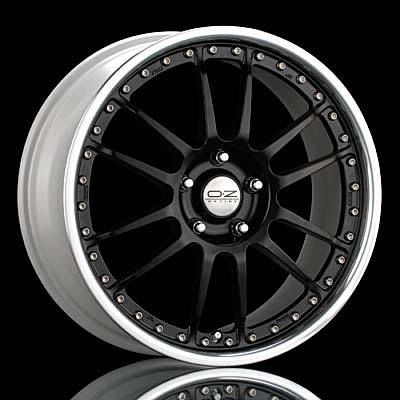In today's consumer-driven society, we have become mostly driven toward such marketing proclamations as new and improved, lighter, larger, better and other hyperbolic statements slapped on a new label to sell an old idea. All too often we don't get what we expected.
A buying decision has to take into consideration the source of the product and make a reasonable determination based on the company's reputation, history and reviews from other buyers on the firm's products.

When it comes to wheels, O.Z. has an outstanding reputation among the world's enthusiasts, tuners, racers, and even some OEM for whom O.Z. supplies wheels for.
O.Z.'s Superleggera wheel is a new twist on its traditional multi-spoke racing-theme wheel, applying advanced modeling techniques to make a strong and lightweight street wheel. Think of it as an updated Super Turismo.
For my application I chose an 8x18 O.Z. Superleggera, both for its look and construction. It's the right size for the 225/40-18 Beetle tires and is a nice step up from the previous 17-in. wheels.
Many people don't think too deeply about the construction and weight of the wheels they buy but rather are more concerned with appearance, followed by fitment and finally construction. This is the absolute wrong way to buy wheels. If you want to know how smart people buy wheels, read Dave Coleman's article on how engineering nerds go wheel shopping (Sport Compact Car, Aug. 2002). In simple terms, weight = bad, wrong fitment = very bad, poor construction = dangerous.

Let's look at the first postulation: weight = bad. It doesn't take a rocket scientist to figure that part out. First, there is the unsprung weight that has to be controlled by the dampers through an up-and-down motion. Added to that is the rotational inertia. Drive any front-wheel-drive car with heavy "sport" wheels and compare those to the stock wheel/tire combination, and you'll see that those sporty performance wheels really aren't. Once again, I turn to Dave Coleman and his words about rotational inertia.
What you need to know is that changing to tires that are 1 lb heavier will effectively add 8 lb to the car (four tires, remember) and that adding a pound to the wheels will effectively add somewhere around 6 lb to the car.
In short, think of heavy wheels in the same respect as having an extra flywheel on each corner. To lend personal perspective, consider the several wheel guides you read each year. We have to unpack, clean, position and photograph a couple hundred wheels in the course of two long days. Most importantly, we weigh them to let you, the reader, know exactly how heavy or light a wheel can be.
Before I had the Spec-2 Paradas mounted, I took the 8x18 O.Z. Superleggera to our mailroom scale for a quick test. Including center cap and minus the stem, it weighed in at a light 18.5 lb, which is really quite good.
Looking through a recent wheel guide, I noted that some 8x18s weigh up to a whopping 29.4 lb! One 7x18 busted the scale (not really) at an unbelievable 35.6 lb. Remember the formula about a pound of wheel weight? In all fairness, most of the wheels were in the mid 20s, and I'm pretty sure there's a wheel or two that weigh less than the O.Z. But I'm not going to split hairs. I'll take peace of mind and reputation over absolute minimums any day. I'm not a gambling man.

Part two of my layman's math states that wrong fitment = very bad. Unless a wheel has been TUeV certified for the car, it doesn't go on. Period. This holds true for each and every wheel I've used on my project cars, as well as those under my care, for a number of reasons. First, I know it's been tested to some standard. Second, there's the simple problem of the handling being disturbed by moving the point around which the tire turns on the ground.
Finally, there is construction. I remember driving a hotted-up Z3 that had a set of "tuner wheels" so poorly constructed, perhaps out of reconstituted beer cans, they would flex when cornering and bung themselves on the brake caliper. I didn't want to be around when that metal finally gave up.
Once again, O.Z. engineers stepped up to the task in its choice of metals. To make a lightweight and strong wheel, the company used computer modeling and finite element analysis, along with a special titanium-enriched alloy. The production process also includes a method of heat treating and shot peening borrowed from the aerospace industry. This means that O.Z. can build an 11-lb, 15-in. wheel and an 18-in. wheel with as little as 17.6 lb.
If you are looking for a wheel that lives up to its reputation, consider the Superleggera. It's available in a satin titanium gray finish, with special applications in white (7x17 4x100 pattern) and gold (Subaru exclusive). Note to self: Buy wheel locks, five sets.
No comments:
Post a Comment